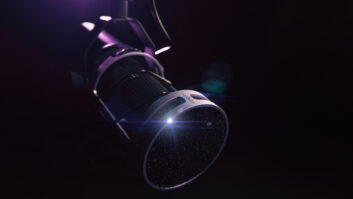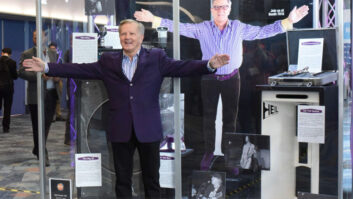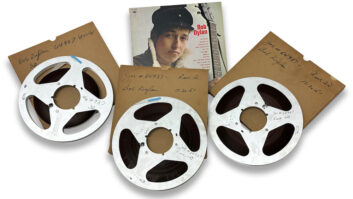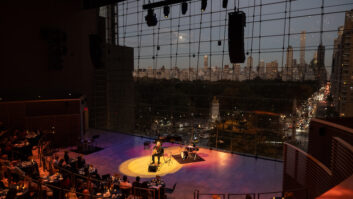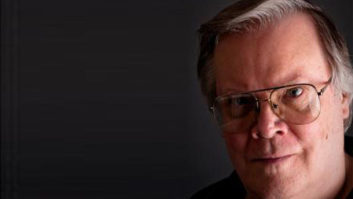Saxophonist, arranger, producer-you’d have to look a while to find someone who brings as much to the table as Bob Belden (maybe back to Quincy Jones when he had his big band in the studio in the 1960s and ’70s). Belden has put his jazz stamp on the music of Sting, Prince, The Beatles, even Puccini’s opera Turandot-his work was the inspiration for the Blue Note Covers Series. Belden has released 13 albums as bandleader; among his most recent is a reworking of Carole King’s classic album Tapestry.
Belden won Grammy awards in 1993 and 1994 for his production work on the McCoy Tyner Big Band’s Turning Point and Journey. He won Record of the Year in Japan for Jacky Terrasson/Cassandra Wilson’s Rendezvous and a 1996 Juno Award (Canada) for Renee Rosnes’ Ancestors. In 1995 he arranged Herbie Hancock’s The New Standard and classical flutist Patrick Gallois’ electronic take on Vivaldi’s “The Four Seasons,” and did horn and string parts for Incognito’s hit album Beneath The Surface. In the past year Belden produced Ed Palermo’s Big Band Zappa, Straight Ahead’s Dance of the Forest Rain, a Freddie Hubbard tribute by Tim Hagans and Marcus Printup called Hubsongs, Bernard Purdie’s Soul to Jazz II, and The Hollywood Bowl Orchestra’s Always and Forever, among others.
Belden grew up in the unlikely location of Goose Creek, South Carolina. He attended the Brevard Music School in North Carolina before heading for North Texas State University and the One O’Clock Band. He was introduced to the studio there, and soon joined Woody Herman’s Thundering Herd, then to New York to begin a producing career by doing television spots.
With a great sense of history and the current marketplace, Belden has also become a popular choice for producing reissues. He won a Grammy in 1996 for Miles Davis/Gil Evans: The Complete Studio Recordings. He also did Miles’ The Complete Studio Recordings 1965-68, the recent Miles Davis Bitches Brew four-CD set, the Weather Report catalog (including a new boxed set), Herbie Hancock’s Headhunters and many other jazz and fusion classics.
As a producer, what’s an ideal project to work on?
If I find somebody that wants to make a sentimental, warm album like Joey Calderazzo did with Secrets on Audio Quest, I say, “Hey, let’s go.” I’m a horrible, incurable, sentimental romantic. It’s the kiss of death in New York critical circles, but I truly believe that when music can make you cry it really goes beyond notes on the page and somebody playing an instrument-it’s an act of God.
This Hollywood Bowl Orchestra record, Always and Forever, is totally romantic and it was a pleasure. You can sit down and listen to this 90-piece orchestra play the romantic tear-jerker themes from famous movies. You don’t have to do much to coax emotion out of it. If the conductor knows what he’s doing then you just let him do what he does.
There are two sides of a recording. There’s a spiritual side that a lot of people romanticize: “Oh, listen to this take-it’s magic and it’s the next ‘Kind Of Blue.'” But the reality of it is that most record dates are approached on a technical level. Can you put the cats in a mood so that they don’t worry about the fact that they’re in a studio; they don’t notice it? You put them in a mood to create and take a chance and find themselves, and that’s really where it’s at. Sometimes they’re looking for someone to say, “Well, this one has the thing. There are some notes here and there that aren’t happening, some little flaws, but it’s got the fire, got the feeling.”
They also want to know that you can fix things, that you can cleverly create correctness. Sometimes there’ll be this perfect take that is marred by a flaw somewhere. It’s generally at the last minute, when people are trying to slide into the groove and somebody hits a clinker or goes to the wrong chord, so it’s helpful to be able to fix things like that. The technology has really got a great advantage.
Actually splicing something in…Or doing an insert, fixing an ending. We’ve been able to edit in and out microseconds to take out distortion. On one particular record we had to fix bass parts like you wouldn’t believe. We’ve taken parts here, parts there, just to correct something that we could never get right. Editing is an art form. I worked with an artist who had 45 edits on a record, and they all worked. These days, with digital editing, you can do so much to make things right.
What are some of the other problems you encounter in the studio?
A main problem is that musicians do not frequent recording studios on a regular enough basis to be completely comfortable with the environment. When you do a session with younger musicians you have to make sure that what they’re playing and hearing is what they want. Sometimes their inability to adapt to that artificial environment is the difference between a good take and a bad take and a good day and a bad day.
It’s important to get people comfortable and focused on the studio. Go to a good enough studio that the engineer has enough control and the artist has enough control and you can do what it is you set out to do. Jazz history has a myth that the studio is a stale environment, and yet 99.9 percent of what we know about jazz comes from the studio. A Love Supreme was done in the studio; Kind of Blue was done in the studio.
I understand that after your Woody Herman Band stint you began producing for ESPN.
You’d learn how to produce a session because there were so many elements that had to come together. In TV and film they were very cost-conscious, because lots of money was riding on it-big union orchestras where ten minutes of overtime was $5,000-so there were pressures. You’d see how teams created the music. You’d have copyists and music supervisors and contractors and arrangers and conductors and concertmeisters all working together to go into the three hours and do a TV movie. You dealt with synchronization of picture and music, you learned what preparation really did for a session. I worked with fastidious people, and it taught me the value of preparation and organization.
Producing a record is a mystery only in the sense that you don’t know what kind of music is going to be made until you get in and kick it off. I wouldn’t take a commission from the studio for the work I’d bring in. I’d ask for recording time. So from the moment I started working at ESPN, I was constantly going in to record. Wallace Roney and I did two quintet dates. Then I did a big band date in ’85, then a record with Joe Chambers. I did eight or nine albums of material. I was constantly recording stuff and rehearsing on a regular basis with Jeff Hirshfield, Jay Anderson, and eventually Marc Copland, with Jim Powell and Gary Smulyan every Wednesday for years. And that eventually became the big band I put together. After I did the Sting session [Straight to My Heart] it became easy to convince people that I could pull it off, because when you manage a large group of people it’s an indication of your ability to organize things.
You have a gift for reworking pop material into the jazz idiom.
When I was with Woody Herman we had an album that we were promoting called Donald, Walter, and Woodrow. One half was Steely Dan material and the other half was Chick Corea’s “Suite for a Hot Band.” And the response we got from the students was amazing. Anytime we played something that was on a pop level, it just went over, no matter if it was abstract. And we turned these tunes into something like late Coltrane if we could, and kids would go nuts. So I’m thinking, this is a great way to communicate to people you don’t think are already converted to your cause. It’s a way to do things that can’t be compared to anybody else.
When I attack a tune there are very few precedents. When Herbie and I were discussing the list that Verve laid on us for The New Standard, it wasn’t, “Oh man, my favorite tune is this, we should do this.” It was like, “Well, there are no fingerprints on these tunes. If the company feels strongly about them let’s try to give them what they want, at the same time satisfying the artistic side of the musicians that are involved.” And if there’s no fingerprints you can do anything. They can say, “I like the original better,” and then you haven’t won that person over, but you get a chance to really experiment with things, like doing “Purple Rain” with a pedal steel. In 1993 it wasn’t exactly used that much, but if you’ve got Holly Cole singing it you can pretty much put anything behind it. You’re given a little deflection.
There’s a song on Tapestry called “Where You Lead,” and I just turned to (guitarist) John Hart and said, “Twin Peaks.” So he turns the vibrato on his amp on. He knew right away what I was talking about-it’s a cultural symbolism of our time and it comes in handy when you’re trying to give a guy a cryptic direction without saying, “Turn your vibrato to seven.” It’s communicating in a personal way to these cats.
Tapestry was a symbolic record for the first generation of the power girl thing in the ’60s and ’70s. That record had a power to it, but beyond that it was sort of the sweet sound of our time. I was reticent about Tapestry because it’s an older piece, but it got me in the studio and we did two other records.
It translates well, and those melodies really hold up.
Yeah, and you only need a portion of them to get the message across. You only need to do it once and everybody knows. “You make me feel…” Smooth jazz’s problem is that there’s nothing of substance behind the melody, and it’s hard to make a record that has some feeling behind it, that’s not designed necessarily to put people in a buying mood. We didn’t exactly go all the way with it, because the last track we take into zone-ville. But this is how we are.
I’ve used the same basic guys since 1993, and we’ve managed to cover all kinds of weird artistic bases. We’re establishing an identity, a group sound, a studio band like Steely Dan. We did a record of Beatles music last year, and the year before that we did Vivaldi’s “The Four Seasons,” and the year before that we did Blue Note classic tunes, and the year before that we did Prince [“When Doves Cry,” “Metro Blue”]. We can do anything we want to.
My idols in music were always Wagner and Alban Berg, people like Bartok and Stravinsky who took care of business and never said “I can’t” about something. I remember in one three- week period I worked on the Radio City Music Hall Christmas Show and Straight Ahead, for Atlantic. Every idea I come up with, I can follow through from ground zero to the finished product. Arrange it, contract it, produce it and play half the instruments.
You’re a very popular reissue producer. Do you enjoy that work?
I describe it as getting paid to listen to music. The key of reissues is not only being able to assess the value of classic material, but to also understand what’s hot in the collector market, what’s hot in the producer tip. Nowadays you can reissue things specifically to encourage people to lift tracks, because the companies make money off of that. So if you put out a Donald Byrd or a Lonnie Smith or a Lou Donaldson, in one hand you may say this is funk music, or it’s not really hard-core bebop. They didn’t go in there with the Holy Grail to make an artistic album, but these guys making the rap records love these intros. They love these parts. You might sell a few thousand, but you might get ten times that money from license fees, because it just happens to be the music of the time.
Now Columbia has started up a fusion trend in reissues, where electric music is getting a little more dignity in the reissue market. GRP is doing it, and Blue Note is putting out some of their electric stuff. The post-alternative rock crowd is looking for different stuff, and jazz guys are bored with straight ahead, so they’re rediscovering Mahavishnu and Weather Report.
Do you get assignments for reissues where you say to yourself, “I can improve that”?
Sonically, yes. Because at Columbia they would make the record, then mix it down to a 2-track master, then take that 2-track master and EQ it, compress it for LPs, make it a certain way to make an LP work. When you first made CDs, people had this feeling that CDs weren’t warm-sounding at all, and a lot of times they would compensate for that by changing the EQ and adding reverb. They would always take the LP and try to create the warmth of an LP master.
But we found that when you go into 24-bit mastering and beyond, the snapshot that the system takes of the music as it passes by the tape head has more depth to it, more detail. You find out that the original recording was fantastic, and that mastering might have taken something away from the music, or added something that wasn’t there. But we find the tape of the mix that the musicians were in the studio listening to, and that tape is generally the most honest reproduction of what they intended their music to be. We’re making CDs, not LPs, and with this new technology it’s like spy planes. With 24-bit, you can hear the environment the musicians recorded in more effectively because there’s more information being processed every moment. There’s a greater element of the sound of the tape now, so you can hear what they really intended.
The mastering has changed now?
It’s a different type of mastering. We’re not trying to re-create the memory of the LP. That was just the delivery system at the time. With CDs and 20-bit mastering, if you find the original tape, you can create the sound of that studio. Because the tape recorders in the ’50s were good, the tape heads were great. When you’re remastering Miles Davis or Chet Baker you go to the cleanest, most accurate generation for your source material, and then you get an idea how many times something has been copied and used as a master tape.
For instance, there’s a track on Four and More, “Joshua.” On the master tape there’s a splice in the piano solo; the entire piano solo is a different tape stock. What it was, something happened to the piano solo-they were making a copy, something happened, dropout. So rather than go and remix the piano solo they took the LP and made a copy onto tape, spliced that in the master, using tape. This obviously happened in the ’70s and the tape they used had to be baked. So we had to pull off that reel of piano solo, bake it, insert it back in, there it was.
They had lost a generation.
Yeah, and when they replaced it they used tape that turned out to be defective. We just remixed Bitches Brew [Miles Davis], and there’s a piece called “Pharaoh’s Dance” that has a lot of edits. We called the original master take, put it up and looked at the edits, the actual physical edits on the tape-to make sure we knew we were going to duplicate it exactly the way they did it.
I mean, it’s phenomenal. You can research it to the point where you can just hold history in your hands. It’s a trip to sit there and hold the Kind of Blue session in your hands or pull out a Bitches Brew reel that nobody’s ever heard. The thing is, we’re trusted to get it right. So you go and find every take, you make sure every tape that you need is there. You’ve got to determine if you’ve got enough tapes for the project, and if it’s the right thing. You gotta A-B stuff, you gotta have a relationship with all these people in order to really be able to do the right thing. You have to know the studio, know the equipment, know what the potential of the equipment is. You have to know when to rein the engineer in from doing too much, or encourage him to do a little more, because he doesn’t want to desecrate a masterpiece.
There’s so many different personalities involved in this business. I’m the guy who actually enjoys being with the technical people more than the management people. I’m more comfortable with mastering than I am with a record company. I’m more comfortable being with the assistant at the studio, because we’re there to do the job. You have a task and you finish it, you get it done. And there’s a subtle challenge of actually doing it in the time you said you’d do it for the price you said you’d do it.
Do you have favorite studios?
I love Avatar Studio C. C has a unique ability to do almost any situation in jazz. I did the Patrick Gallois “The Four Seasons” there with my multi-keyboard band. We just did Marcus Printup there on a no-headphone date, where you just do it natural, just hearing it the way it is. And we did Conrad Herwig’s The Latin Side of Coltrane there. It’s ideally designed for jazz, with interconnecting glass panes and doors that can be formed into small rooms or opened up. And I love Sony Studio D because it’s got a great Neve board and one of the best lounges in the world.
For me the best kind of lounge has a wide-screen satellite television. Because when you mix, man, you don’t want to sit in there listening for two hours while the guy scopes it out. You want to go in there and hear it, and go, “Oh okay, I like it, let’s do this,” or, “I don’t like it.” But you don’t want to sit there and go, “Okay, now that you finished the bass drum let’s hear the tom tom EQ.”
I like Clinton A because it’s got a big live room sound and a beautiful Neve board. When you do live-to-2-track there with everybody in the room you get a real earthy jazz sound. Bill Stewart’s records were done there, and Kevin Hays’ last record, and those were both done live-to-2-track analog.
I like 2-track analog SR, and 16-track 2-inch 15 ips analog. And I like 48 digital. 24 analog is the basic, but you can do so much with 48 digital. We did the reissue of Charles Mingus in France, and we took that from a 2-inch 16-track analog master and we dropped it into a 20-bit, 24-track Sony digital. And we did all our editing to another 20-bit, 24-track digital Sony, and mixed it to a 24-bit optical. We put that record together like Mingus would have wanted, like classical music, like modern symphonic work, and Sony’s a place where you can do that kind of stuff.
Do you have favorite engineers?
I’ve got four whom I work with most of the time-Jim Anderson, David Baker, James Farber and Scott Noll. But I like Peter Darmi, Joe Ferla, Bob Katz is cool at Chesky. I like Paul Moss on the West Coast. Who can not like Al Schmitt, who can not like Phil Ramone? So many cats are so good, especially in pop engineering.
Pop engineering is almost like painting. It’s incredibly difficult for someone coming from the jazz side of things to get a pop vibe, because you just don’t have the time in some cases to really get it right. I did the Prince record, and we would sometimes spend two days on a mix. We were doing 72-channel mixes. On “Diamonds And Pearls,” Phil Perry was singing 15 vocal parts with 30 instruments on it and a double rhythm section. Sometimes we get a little sick. But it’s fun when you can go into the studio and do a 72-track mix.
We went out to the West Coast last year to do some tracks just because I wanted to go to the Village Recorder. They have a live chamber that’s controlled by a concrete door opening and closing into a room with glass and metal on a concrete floor, and they stick a mic and a speaker in there. You can bring the live sounds into it too by opening the door.


